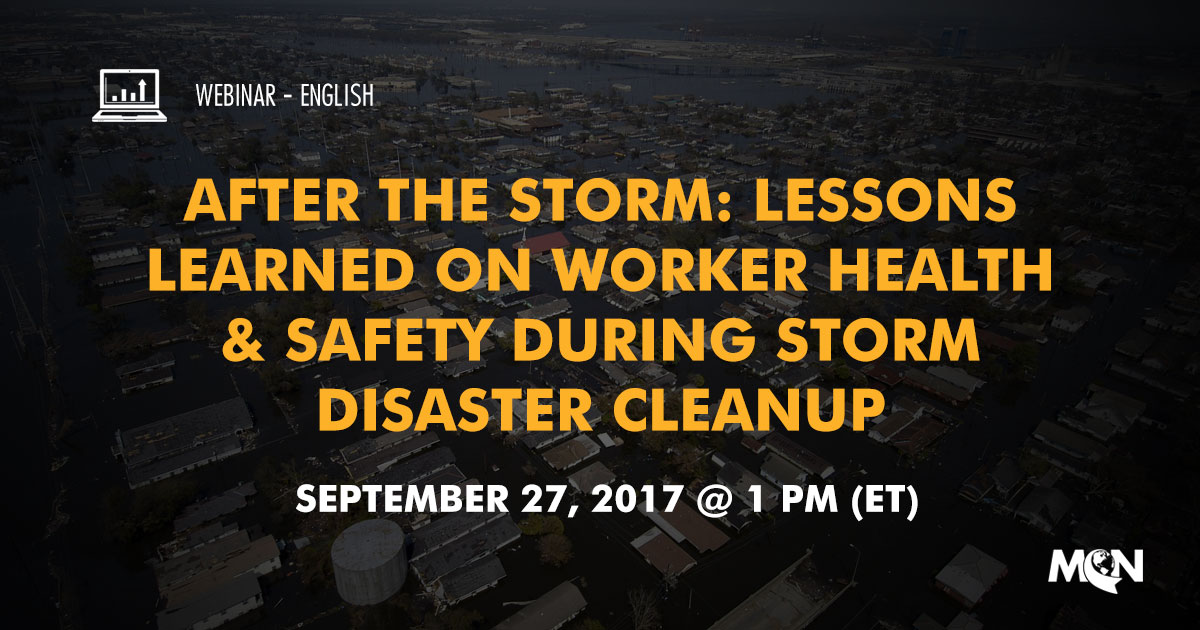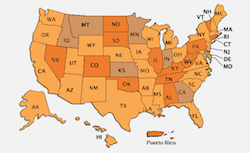- Who We Are
- Clinician Employment
- Publications
- Witness to Witness (W2W)
- Kugel & Zuroweste Health Justice Award
- Your Voice Matters: Photovoice Project

DATE: September 27, 2017, 1 pm (ET)
SPEAKERS:
- Joseph “Chip” Hughes, Jr., MPH, National Institute of Environmental Health Sciences
- Amy K. Liebman, MPA, MA, Migrant Clinicians Network
- Juliana Simmons, MSPH, CHES, Migrant Clinicians Network
Continuing Education Credit
To receive CME* or CNE credit after viewing this webinar, you must:
- Register and watch the Recorded Webinar and complete the Participant Evaluation accessible at the end
- Send an email with your first and last name stating which webinar you completed to contedu@migrantclinician.org
Description
As families return to their homes in Houston as floodwaters from superstorm Harvey recede, it is a race against time. A suffocating smell already fills the living rooms, puddles remain in hallways, and spots of mold multiply quickly. Within days, the soppy lawns of neighborhoods are dump sites as workers begin gutting homes, pulling out molding drywall, damaged floors and ceilings, and wrecked furniture. In the process, these workers and many residents are exposed to mold, water contaminated with chemicals and waste, hazardous building materials, and vermin. Additional risks include working around unstable structures and carbon monoxide poisoning from generators operating in poorly ventilated spaces. Exposure to asbestos, silica and lead are also common for these workers.
Katrina, Sandy, Harvey, Irma: the names of the storms denote which communities ended up under water, but many of the stories of cleanup -- and the hazards involved -- are the same. With resilience and determination, communities will try to rebuild, but the rebuilding necessitates an immediate workforce ready for strenuous and dangerous jobs. Post-disaster recovery, cleanup, and reconstruction operations present numerous risks and dangers to workers. Many do this work without proper safety equipment or training on hazard mitigation.
In post superstorm recovery, what are the vulnerabilities workers face and what does this mean for worker safety and worker health? As clinicians and community health workers caring for this worker population, what are the key points we need to understand to care for those involved in clean up efforts and what can we do to help educate them to prevent injuries and illnesses?
This webinar brings together experience from previous natural disasters and offers resources that will help guide you. We will offer case studies to illustrate the hazards `and review ways that workers can protect themselves, including understanding their rights and responsibilities.
Learning Objectives
- Identify the most critical and common hazards encountered by workers and residents engaged in post-disaster demolition and reconstruction.
- Articulate the best strategies to educate workers and others about how to prevent injuries and illness during the clean-up following hurricanes and superstorms.
- List at least three resources they can use to guide workers and residents during post-disaster demolition and reconstruction.
This project is supported by the Health Resources and Services Administration (HRSA) of the U.S. Department of Health and Human Services (HHS) under cooperative agreement number U30CS09742, Technical Assistance to Community and Migrant Health Centers and Homeless for $1,094,709.00 with 0% of the total NCA project financed with non-federal sources. This information or content and conclusions are those of the author and should not be construed as the official position or policy of, nor should any endorsements be inferred by HRSA, HHS or the U.S. Government.
Resources
Occupational Safety and Health Administration (OSHA)
- OSHA Hurricane Preparedness, Response, and Recovery (webpage) Comprehensive hurricane information including links to preparedness and response/recovery pages.
- OSHA Flood Preparedness, Response, and Recovery (webpage). Comprehensive flood information including links to preparedness and response/recovery pages.
- Keeping Workers Safe during Hurricane Cleanup and Recovery Fact Sheet in English and Spanish. This resource addresses potential hazards and protective measures that apply to cleanup workers.
- Disaster Cleanup and Recovery PPE Matrix in English and Spanish. This resource details which PPE should be utilized depending on the type of activity taking place.
- Mold Hazards during Disaster Cleanup in English and Spanish. This resource addresses mold as a health hazard, including recommended PPE and other protective measures for workers.
National Institute of Environmental Health Sciences (NIEHS)
- Safety Awareness for Responders to Hurricanes: Protecting Yourself While Helping Others in English and Spanish. This comprehensive guide to protective measures for cleanup workers covers a wide variety of potential hazards.
National Council for Occupational Safety and Health (NCOSH)
- How You Can Help: #SafeCleanUp from Hurricane Harvey (Webpage). This site includes various helpful links including information on health hazards, mold remediation, respirator use, and related policy information.
Centers for Disease Control and Prevention (CDC)
- Medical Management and Patient Advisement After a Disaster (Webpage): This page highlights important tools for clinicians as well as diagnoses to consider when caring for disaster-affected patients.
- Clean Up Safely After a Disaster Factsheet. Offers tips about potential hazards and protective strategies during disaster cleanup.
American Public Health Association (APHA)
- Keeping Food and Water Safe in an Emergency Situation (Webpage). Information on keeping food and water safe for consumption and best hygiene practices in the face of disasters.
U.S. Department of Labor (DOL)
- Blog post highlighting common hazards during hurricane cleanup as well as links to additional readings.
Barry Commoner Center for Health and the Environment
- Post Disaster Toolkit for Training Clean-up and Reconstruction Laborers. This resource offers training for community based organizations and workers in the aftermath of natural disasters. It includes educational materials as well as trainer guides and tools.
Clinician Resources for Occupational Injuries and Illnesses
- MCN’s Environmental and Occupational Health Screening Questions - Three concise and effective environmental/occupational health screening questions for the primary care provider. English/Spanish
- MassCOSH: Addressing Work-related Injuries and Illnesses: A Guide for Primary Care Providers in Massachusetts - Offers basic screening questions, common occupations and ailments associated with them, as well as recommended treatment. Also includes sample letters from clinicians to employers for restricted work.
Files




